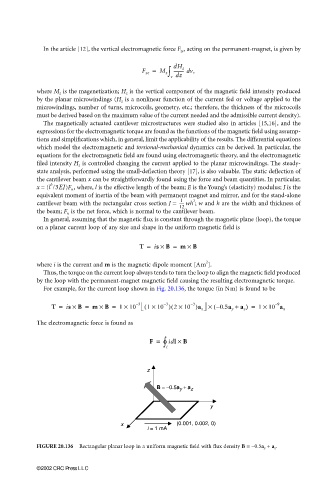Page 647 - The Mechatronics Handbook
P. 647
0066_Frame_C20.fm Page 117 Wednesday, January 9, 2002 1:47 PM
In the article [12], the vertical electromagnetic force F ze , acting on the permanent-magnet, is given by
F ze = M z ∫ dH z
--------- v,d
v dz
where M z is the magenetization; H z is the vertical component of the magnetic field intensity produced
by the planar microwindings (H z is a nonlinear function of the current fed or voltage applied to the
microwindings, number of turns, microcoils, geometry, etc.; therefore, the thickness of the microcoils
must be derived based on the maximum value of the current needed and the admissible current density).
The magnetically actuated cantilever microstructures were studied also in articles [15,16], and the
expressions for the electromagnetic torque are found as the functions of the magnetic field using assump-
tions and simplifications which, in general, limit the applicability of the results. The differential equations
which model the electromagnetic and torsional-mechanical dynamics can be derived. In particular, the
equations for the electromagnetic field are found using electromagnetic theory, and the electromagnetic
filed intensity H z is controlled changing the current applied to the planar microwindings. The steady-
state analysis, performed using the small-deflection theory [17], is also valuable. The static deflection of
the cantilever beam x can be straightforwardly found using the force and beam quantities. In particular,
3
x = (l /3EJ )F n , where, l is the effective length of the beam; E is the Young’s (elasticity) modulus; J is the
equivalent moment of inertia of the beam with permanent magnet and mirror, and for the stand-alone
1 3
cantilever beam with the rectangular cross section J = ----- wh ; w and h are the width and thickness of
12
the beam; F n is the net force, which is normal to the cantilever beam.
In general, assuming that the magnetic flux is constant through the magnetic plane (loop), the torque
on a planar current loop of any size and shape in the uniform magnetic field is
T = is × B = m × B
2
where i is the current and m is the magnetic dipole moment [Am ].
Thus, the torque on the current loop always tends to turn the loop to align the magnetic field produced
by the loop with the permanent-magnet magnetic field causing the resulting electromagnetic torque.
For example, for the current loop shown in Fig. 20.136, the torque (in Nm) is found to be
T = is × B = m × B = 1 × 10 – 3 ( 1 × 10 ) 2 × 10 )a z × – ( 0.5a y + a z ) = 1 × 10 a x
(
9
–
–
3
–
3
The electromagnetic force is found as
F = ∫ l ° idl × B
z
B = −0.5a + a z
y
y
x (0.001, 0.002, 0)
i = 1 mA
FIGURE 20.136 Rectangular planar loop in a uniform magnetic field with flux density B = −0.5a y + a z .
©2002 CRC Press LLC

